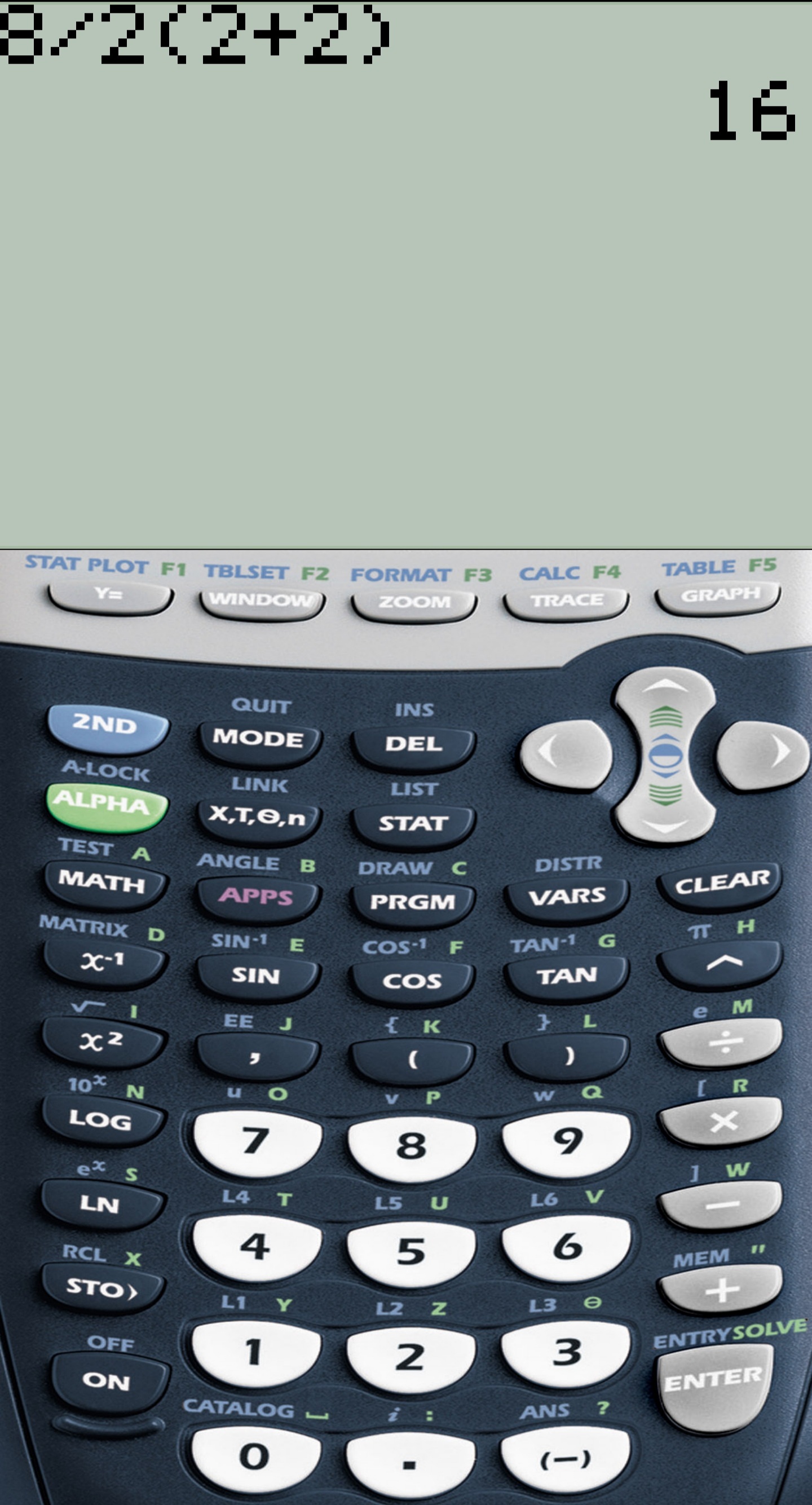People in this thread need to watch this: https://youtu.be/lLCDca6dYpA
For anyone like me who has math as their worst subject: PEMDAS.
PEMDAS is an acronym used to mention the order of operations to be followed while solving expressions having multiple operations. PEMDAS stands for P- Parentheses, E- Exponents, M- Multiplication, D- Division, A- Addition, and S- Subtraction.
So we gotta do it in the proper order. And remember, if the number is written like
2(3)then its multiplication, as if it was written2 x 3or2 * 3.So we read
8/2(2+2)and need to do the following;- Read the Parentheses of
(2 + 2)and follow the order of operations within them, which gets us 4. - Then we do
2(4)which is the same as2 x 4which is8 8 / 8is1.
The answer is 1. The old calculator is correct, the phone app which has ads backed into it for a thing that all computers were invented to do is inaccurate.
The problem is that the way PEMDAS is usually taught multiplication and division are supposed to have equal precedence. The acronym makes it look like multiplication comes before division, but you’re supposed to read MD and as one step. (The same goes for addition and subtraction so AS is also supposed to be one step.) It this example the division is left of the multiplication so because they have equal precedence (according to PEMDAS) the division applies first.
IMO it’s bad acronym design. It would be easier if multiplication did come before division because that is how everyone intuitively reads the acronym.
Maybe it should be PE(M/D)(A/S). But that version is tricky to pronounce. Or maybe there shouldn’t be an acronym at all.
but you’re supposed to read MD and as one step
You can do them in any order at all - M then D, D then M (hence the acronym BEDMAS), or all in one - what does matter is not treating Distribution as though it’s Multiplication (which refers literally to multiplication signs), when in actual fact it’s the first step in solving Brackets.
PEMDAS evaluated from left to right. If you followed that you’d get 16. 1 is ignoring left to right.
1 isn’t ignoring anything. 16 can be arrived at by ignoring any one of multiple order of operations rules.
removed by mod
Then I admit I’m wrong, I just don’t get how PEMDAS/I got it wrong.
You got it right
Short story, PEMDAS kinda sucks, because it has 4 levels of priority, but 6 letters:
- P
- E
- MD
- AS
M and D are the same level, priority is from left to right.
A and S are the same level, priority is from left to right.Just tested this on a Ti-83 too.
8/2(2+2) = 16

TI calculators disobey The Distributive Law and give the wrong answer when a bracketed term has a coefficient.
I love you brought the TI truth lul
My calculator gets 1. Weird.
My calculator gets 1
That is the correct answer.
I thank you for proving me right, but this a 4 month old thread. Not complaining, just giving you a heads up.
And also if I hadn’t been replying to this thread then you wouldn’t have got the proof that you were right. :-)
this a 4 month old thread
Yeah, I know, but it’ll show up in search results for all eternity, and it’s full of disinformation. As a Maths teacher/tutor who is sick of hearing “But Google/Wolfram/TI says…”, I’m doing my best to try and get said people to fix their damn calculators (and also make people aware that those calculators are wrong. (sigh) I miss the old days when all calculators gave the right answer - what happened??). If you feel the same way then feel free to share my links - that’s what they’re there for. :-)
And right at the moment I’m feeling too tired to do anything which requires me to think about it, so just doing what I can do on automatic. ;-)
My one big criticism of the Ti-83/84 is implicit multiplication. Ti says 1/2x is 0.5x when I needed the reciprocal of 2x.
Yeah, that’s exactly the problem with TI calculators - ignoring the rules of Maths.
Me searching the place for my old Ti83 after stumbling on this thread.
My partner: why are you even looking for this thing??
Me: Somebody on the Internet is WRONG.
My partner: Good enough, I’ll help!
removed by mod
I know, it’s good to have someone in your life with priorities.
I happened to have my ti-83 plus next to me. I got 16!
YES finally, some sense in here. 🤣
I ended up downloading a Ti-83 emulator because mine has been devoured by the magical house gremlins.
Except TI calculators also give the wrong answer when a bracketed term has a coefficient.
not to be That Guy, but the phone is actually correct… multiplication and division have the same precedence, so
8 / 2 * 4should give the same result as8 * 4 / 2, ie 16but the phone is actually correct
No, it’s actually wrong.
8 / 2 * 4
It’s 8/(2x4). You can’t remove brackets unless there is only 1 term left inside.
Uh… no the 1 is wrong? Division and multiplication have the same precedence, so the correct order is to evaluate from left to right, resulting in 16.
The real correct order is to use brackets to remove ambiguity.
Exactly, these types of problems are designed to make people confused and discuss PEMDAS and drive social media engagement.
There’s no multiplication in this question - multiplication refers literally to multiplication signs - only division and brackets, and addition within the brackets. So you have to use The Distributive Law to solve the brackets, then do the division, giving you 1.
Well that’s just wrong… Multiplication and division have equal priorities so they are done from left to right. So: 8 / 2 * (2 + 2)=8 / 2 * 4=4 * 4=16
Not quite, pemdas can go either from the left or right (as long as you are consistent) and division is the same priority as multiplication because dividing by something is equal to multiplying by the inverse of that thing… same as subtraction being just addition but you flip the sign.
8×1/2=8/2 1-1=1+(-1)
The result is 16 if you rewrite the problem with this in mind: 8÷2(2+2)=8×(1/2)×(2+2)
8÷2(2+2)=8×(1/2)×(2+2)
No, that’s wrong. 2(2+2) is a single term, and thus entirely in the denominator. When you separated the coefficient you flipped the (2+2) into the numerator, hence the wrong answer. You must never add multiplication signs where there are none.
I’ve never had anyone tell me operations with the same priority can be done either way, it’s always been left to right.
I’ve always heard it that way too but I think it is for consistency with students, imo Logically, if you are looking at division = multiplying by inverse and subtraction = adding the negative, you should be able to do it both ways. Addition and multiplication are both associative, so we can do 1+2+3 = (1+2)+3 = 1+(2+3) and get the same answer.
But subtraction and division are not associative. Any time you work on paper, 2 - 2 - 2 would equal -2. That is, (2-2)-2=0-2=-2. If you evaluate right to left, you get 2-2-2=2-(2-2)=2-0=2
2-(2-2)
But you broke the rule of left-associativity there. You can go right to left provided you keep each number with the sign to it’s left (and you didn’t do that when you separated the first 2 in brackets from it’s minus sign).
Correct, subtraction and division are not associative. However, what is subtraction if not adding the opposite of a number? Or division if not multiplying the inverse? And addition and multiplication are associative.
2-2-2 can be written as 2 + (-2) + (-2) which would equal -2 no matter if you solve left to right, or right to left.
In your example with the formula from right to left, distributing the negative sign reveals that the base equation was changed, so it makes sense that you saw a different answer.
2 - (2 - 2) = 2 + ((-2) + 2) = 2
I’ve never had anyone tell me operations with the same priority can be done either way, it’s always been left to right
It’s left to right within each operator. You can do multiplication first and division next, or the other way around, as long as you do each operator left to right. Having said that, you also can do the whole group of equal precedence operators left to right - because you’re still preserving left to right for each of the two operators - so you can do multiplication and division left to right at the same time, because they have equal precedence.
Having said that, it’s an actual rule for division, but optional for the rest. The actual rule is you have to preserve left-associativity - i.e. a number is associated with the sign to the left of it - and going left to right is an easy way to do that.
Implicit multiplication takes priority over explicit multiplication or division. 2(2+2) is not the same thing as 2*(2+2).
Correct! 2(2+2) is a single term - subject to The Distributive Law - and 2x(2+2) is 2 terms. Those who added a multiply sign there have effectively flipped the (2+2) from being in the denominator to being in the numerator, hence the wrong answer.
But it’s not called “implicit multiplication” - it’s Terms and/or The Distributive Law which applies (and they’re 2 separate rules, so you cannot lump them together as a single rule).
This but unironically
8 / 2 * (2 + 2)
That’s not the same as 8 / 2 (2 + 2). In the original question, 2(2+2) is a single term in the denominator, when you added the multiply you separated it and thus flipped the (2+2) to be in the numerator, hence the wrong answer.
P E M D A S
vs
P E M/D A/S
The latter is correct, Multiplication/Division, and Addition/Subtraction each evaluate left to right (when not made unambiguous by Parentheses). I.e., 6÷2×3 = 9, not 1. That said, writing the expression in a way that leaves ambiguity is bad practice. Always use parentheses to group operations when ambiguity might arise.
You are correct. This is the right sequence of operations done here.
Turns out I’m wrong, but I haven’t been told how or why. I’m willing to learn if people actually tell me
Well, I don’t know what you said originally, so I don’t know what it is you were told was wrong - 1 or 16? 😂 The correct answer is 1.
Anyhow, I have an order of operations thread which covers literally everything there is to know about it (including covering all the common mistakes and false claims made by some). It includes textbook references, historical Maths documents, worked examples, proofs, memes, the works! I’m a high school Maths teacher/tutor - I’ve taught this topic many times.
Ignore the idiots telling you you’re wrong. Everyone with a degree in math, science or engineering makes a distinction between implicit and explicit multiplication and gives implicit multiplication priority.
The problem with this is that the division symbol is not an accurate representation of the intended meaning. Division is usually written in fractions which has an implied set of parenthesis, and is the same priority as multiplication. This is because dividing by a number is the same as multiplying by the inverse, same as subtracting is adding the negative of a number.
8/2(2+2) could be rewritten as 8×1/2×(2+2) or (8×(2+2))/2 which both resolve into 16.
Division is usually written in fractions
Division and fractions aren’t the same thing.
fractions which has an implied set of parenthesis
Fractions are explicitly Terms. Terms are separated by operators (such as division) and joined by grouping symbols (such as a fraction bar), so 1÷2 is 2 terms, but ½ is 1 term.
8/2(2+2) could be rewritten as 8×1/2×(2+2)
No, it can’t. 2(2+2) is 1 term, in the denominator. When you added the multiply you broke it into 2 terms, and sent the (2+2) into the numerator, thus leading to a different answer. 8/2(2+2)=1.
You left out the way it can be rewritten which most mathematicians would actually use, which is 8/(2(2+2)), which resolves to 1.
You’re a lifesaver, thank you so much. I actually didn’t know about PEMDAS, I was never taught it before…
removed by mod
Ohh, I see. Thank you for clarifying, Math has always been the bane of my existence. x_x
- Read the Parentheses of
The correct answer is 16. Multiplication and Division happen at the same level of priority, and are evaluated left-to-right.
PEMDAS be damned?
PEMDAS should be read as Parentheses, Exponents, Multiplication and Division, Addition and Subtraction. There are four levels of priority, not six.
No it’s ambiguous, you claiming there is one right answer is actually wrong.
It is not ambiguous at all, there absolutely is one right answer, and it is 16.
You’re taking something you learned when you were like 9 years old and assuming it’s correct in every situation forever.
Unfortunately this isn’t the case and you’re incorrect.
Inaccurate, this has nothing to do with the mnemonic PEMDAS, this has to do with the actual order of operations it tries to instill. That order of operations is not ambiguous, there is a correct way to solve simple equations like the one above, and there is one and only one correct answer to it. That answer is 16.
And in the “actual” order of operations, if we want to pretend one exists,
2(binds more tightly than÷if you’re going via prescriptivism, then you’re wrong, because there are plenty of authoritative sources following the left hand model
if you’re going via descriptivism, then you’re wrong, because this thread exists
No, 2( does not bind more tightly than ÷. 2( is simply 2×(…, and ÷ and × occur at the same level of priority. After resolving the addition in the parentheses, the remaining operations are resolved left to right.
if you’re going via prescriptivism, then you’re wrong, because there are plenty of authoritative sources following the left hand model
if you’re going via descriptivism, then you’re wrong, because this thread exists
2( is simply 2×(
No it isn’t. 2(a+b)=(2a+2b) The Distributive Law
But there actually is only 1 right answer, and unfortunately for the person you’re replying to it’s 1.
deleted by creator
I’m with the right answer here. / and * have same precedence and if you wanted to treat
2(2+2)as a single unit, you should have written it like(2*(2+2)).deleted by creator
Left is correct; implicit multiplication takes precedence over explicit multiplication or division.
What the fuck is the difference in implicit vs explicit? It’s the same operation, why the fuck does it matter if there is a symbol?
Multiplication comes first, then division.
the difference in implicit vs explicit? It’s the same operation
“implicit multiplication” isn’t even a real thing in Maths, and isn’t even multiplication to begin with - people use that umbrella term to either mean The Distributive Law - which is the first step is solving Brackets - or Terms, which are products, which is the result of a multiplication.
e.g. if a=2 and b=3, then…
axb=2x3 - 2 terms
ab=6 - 1 term
Multiplication comes first, then division
They can be done in either order, or even together, as long as you go left to right.
Division is a form of Multiplication, just as subtraction is a form of addition. You multiply and divide in the same step, left to right
No, multiplication and division are resolved from left to right in the same step. But implicit multiplication (
xy, as opposed tox*y) happens first.
What’s the difference between implicit multiplication and explicit multiplication?
Implicit multiplication is xy or x(y), explicit multiplication is x*y.
Basically just whether or not there’s an actual multiplication symbol.
Right idea, but wrong terminology.
There’s no such thing as implicit multiplication
xy is a Term - Terms are separated by operators (none in this case) and joined by grouping symbols.
x(y) is a Bracketed Term, and is therefore subject to The Distributive Law, which is the first step in solving Brackets.
And yes, a multiplication symbol is an operator - which therefore separates Terms (which is why ab and axb aren’t the same thing - it’s 1 term vs. 2 terms), and the “M” in the mnemonics refers literally to multiplication signs, and nothing else.
deleted by creator
Agree completely. Old school calculator is wrong, but why? Pemdas wasn’t really big in school curriculums until around the turn of the century, but the order of operations existed at the previous turn of the century, and should operate correctly on every digital calculator ever made…
Old school calculator is wrong
No, it’s right. The e-calculator is wrong.
the order of operations existed at the previous turn of the century, and should operate correctly on every digital calculator ever made
Yes, they should - welcome to what happens when programmers don’t bother checking their Maths is correct when writing a calculator app (hence why I wrote the thread I linked to above).
deleted by creator
The ad filled app sucks for sure, but it is correct in this case.
There’s 4 levels to PEMDAS, not 6.
- Parenthese
- Exponent
- Multiplication or Division
- Addition or Substraction
Also,
an actual PEMDAS Solver:
https://www.symbolab.com/solver/step-by-step/8\div2(2%2B2)?or=inputan actual PEMDAS Solver
I looked and it’s actually wrong. With the exception of MathGPT, I haven’t found any e-calcs which do it correctly.
Nope. It’s PEMDAS at work.
8/2(2+2)
8/2(4) - Parentheses
8/8 - Multiplication
1 - Division
Modern phone apps seem to be notorious for getting order of operations wrong. I’ve never had this issue with a dedicated calculator.
Edit: my petard has been hoisted
just requires using the proper calculator:
2 2 + 2 * 8 / .Yes correct! I just had someone else here claim you couldn’t do it with RPN - took me no time at all to show he was wrong about that! 😂
You don’t do multiplication before division, they’re equal operations, so you go left to right. 8 x 0.5 (2 + 2) is the same from a mathematical point of view.
My public school education on pemdas is that for multiplication/division and addition/subtraction, you do them on order from left to right. Doing it that way gets me 16, which I believe to be right, but I’m also very bad at math. The way you had explained is also technically correct, if you do the multiplication out of order. Now that I think about it, you could solve for the parentheses by multiplying 2+2 by two, giving you 8/8 quicker and still yielding 1. I’m now having more doubts about my math capabilities, both are right, but I know that’s wrong, I just don’t know why
you could solve for the parentheses by multiplying 2+2 by two, giving you 8/8 quicker and still yielding 1. I’m now having more doubts about my math capabilities
No, that’s the correct way to do it, as per The Distributive Law.
both are right
No, only 1 is right. If you get 16 then you did division before finishing solving brackets.
It’s 16 my dude
deleted by creator
2+2 first because P. That’s 4.
P is 2(2+2)=(2x2+2x2)=(4+4)=8
Then 8/2 because it’s left of 4(4).
If you do 8/2 when you still have brackets, then you just did division before brackets and disobeyed order of operations rules. You also broke the rule of Terms, since 2(4) is a single term.
Don’t take my word for it.
I see you didn’t read my thread then. I have a section on calculators, which points out that WolframAlpha does it wrong. i.e. they also break the rule of Terms.
I’ve always been taught that + and - were interchangeable with each other for pemdas, as well as * and /. So the hierarchy is
- parenthesis
- exponents
- multiplication, division
- addition, subtraction
8/2(4) - Parentheses
8/8 - Multiplication
Correct steps, but wrong names. Where you said “multiplication” is actually still parentheses - that first step isn’t finished until you have removed them (which isn’t until after you have distributed and simplified, which you did do correctly).
Modern phone apps seem to be notorious for getting order of operations wrong
Yes, I know, and as a Maths teacher I am well and truly sick of hearing “but Google says…”, and so I wrote this thread to try and get developers to fix their damn calculators.
Actively wrong.
PE(MD)(AS).
Parenthesis comes first, do everything in each of them as though they were a whole equation to themselves.
8/2(2+2) = 8/2(4)
Then you do your exponents. The equation doesn’t have any, so we can go ahead and skip those.
Multiplication and division are the same operation, just flipped around, so you go left to right and do those as you come across them. A number next to a parenthesis means multiplication, so to simplify:
8/2(4) = 8/2x4
8/2x4 = 4x4
4x4 = 16
Addition and subtraction don’t have any weird effects on the outcomes of each other, so you go left to right and do them as they come up. This equation has no more addition or subtraction to do, so we can consider what we have left our answer.
Therefore: 8/2(2+2)=16
This is straight from the textbook. You are wrong, and so are your purpose-built calculators.
EDIT: Replaced * with x to avoid italicising.
You’re not wrong but ease off the throttle dude lol
8/2(2+2) = 8/2(4)
Then you do your exponents
You haven’t finished Brackets yet! The next step is…
8/(2x4)=8/8
This is straight from the textbook
Not any textbook I’ve seen. Screenshot? Here’s some actual textbooks
Child, this thread is literally four months old. Get a life.
Yeah, didn’t think that came from any textbook.
Replaced * with x to avoid italicising.
You can do this without needing to replace by using a backslash. 1*2 comes from
1\*2.Anyway, the problem with your logic is that it’s using rules designed for primary school by one random primary school teacher many decades ago. Not a rigorous mathematical convention.
In real maths, mathematicians frequently use juxtaposition to indicate multiplication at a higher priority than division. Rather than BIDMAS, something like BIJMDAS might work. But that isn’t as catchy, and more to the point: it requires understanding of an operation that doesn’t get used in primary school, so would be silly to put in to a mnemonic designed to aid probably school children.
the problem with your logic is that it’s using rules designed for primary school
Actually The Distributive Law is taught in Year 7. The Primary School rule, which doesn’t include brackets with coefficients, is only the intermediate step.
many decades ago. Not a rigorous mathematical convention
It’s an actual rule which is centuries old.
mathematicians frequently use juxtaposition to indicate multiplication
It’s not multiplication - it’s either The Distributive Law or Terms, which are 2 separate rules.
an operation that doesn’t get used in primary school
Yes, as I said it’s taught in Year 7.
When I was in school, year 7 was primary school.
Anyway, I’m the time that is relevant here is when you’ve done the various relevant mathematical tools, but haven’t yet been exposed to multiplication by juxtaposition. Which I’m fairly sure for me at least was in year 6.
It’s an actual rule which is centuries old.
No, the idea of specifically codifying BIDMAS comes from the early 1900s.
I don’t know why you’re going throughout this thread over multiple hours spamming out your nonsense, but it’s wrong. BIDMAS is a convention, and a very useful one, but only because we instinctively know juxtaposition actually comes before explicit multiplication or division, and a rigid primary school application of BIDMAS will lead you to the wrong answer.
Thankfully, I think you know that last part. Because I think that’s what you mean when you keep saying “it’s called terms”. But that, too, is wrong. It’s used in terms, for sure. y = 2x2 + 91/2)x - 4 contains three terms, the x2 term is 2x2, etc. But if I then changed the constant term to be 4(2 - 3×5) + 1, all of that would still only be the one term. Terms and multiplication by juxtaposition can work together, but fundamentally refer to entirely different aspects of mathematics. Juxtaposition is a notational thing, while terms are a fundamental aspect of the equation itself.
When I was in school, year 7 was primary school
Oh really? My apologies then. I’ve only ever heard Year 7 called high school or middle school, never primary school. What country is that in?
multiplication by juxtaposition. Which I’m fairly sure for me at least was in year 6
I’ve seen some Year 6 classes do some pre-algebra (like “what number goes in this box to make this true”), but Year 7 is when it’s properly first taught. Every textbook I’ve ever seen it in has been Year 7 (and Year 8, as revision).
Also, it’s not “multiplication by juxtaposition”, since it’s not multiplication - it’s The Distributive Law - which is Distribution - and/or Terms - which is a product, which is the result of a multiplication.
No, the idea of specifically codifying BIDMAS comes from the early 1900s
The order of operations rules are older than that - we can see in Lennes’ letter (1917) that all the textbooks were already using it then, and Cajori says - in 1928 - that the order of operations rules are at least 300 years old (which now makes them at least 400 years old).
If you’re talking about when was the mnemonic BIDMAS made up, that I don’t know, but the mnemonics are only ways to remember the rules anyway, not the actual rules.
I don’t know why you’re going throughout this thread
I’m a Maths teacher, that’s what we do. :-)
a rigid primary school application of BIDMAS will lead you to the wrong answer
Only if the bracketed term has a coefficient (welcome to how Texas Instruments gets the wrong answer), which is never the case in Primary School questions - that’s taught in Year 7 (when we teach The Distributive Law).
juxtaposition actually comes before explicit multiplication… I think that’s what you mean when you keep saying “it’s called terms”
Terms come before operators, and we never call it juxtaposition, because The Distributive Law is also what people are calling “strong juxtaposition” (and/or “implicit multiplication”), but is a separate rule, so to lump 2 different rules together under 1 name is where a lot of people end up going wrong. There’s a Youtube where the woman gets confused by a calculator’s behaviour and she says “sometimes it obeys juxtaposition and sometimes it doesn’t” (cos she lumped those 2 rules together), and I for one can see clear as day the issue is it’s obeying Terms but not obeying The Distributive Law (but she lumped them together and doesn’t understand these are 2 separate behaviours).
Terms and multiplication by juxtaposition can work together
But that’s my point, there’s no such thing as “multiplication by juxtaposition”. A Term is a product, which is the result of a multiplication.
If a=2 and b=3 then…
axb=2x3 - 2 terms
ab=6 - 1 term
In the mnemonics “Multiplication” refers literally to multiplication signs, and nothing else. The Distributive Law is done as part of solving Brackets, and there’s nothing that needs doing with Terms, since they’re already simplified (unless you’ve been given some values for the pronumerals, in which case you can substitute in the values, but see above for the correct way to do this with ab, though you could also do (2x3), but absolutely never 2x3, cos then you just broke up the term, and get the wrong answer - brackets can’t be removed unless there is only 1 term left inside. People writing 2(3)=2x3 are making the same mistake).
Just looked it up. Everything I know is a lie. Thank you, kind stranger on the internet. I’m going to go have an existential crisis, now.
Everything I know is a lie
…including the comment you just replied to. Here is a thread with actual textbook references, historical Maths documents, worked examples, proofs, the works.
In PEMDAS M does not get priority over D so the equation has to be executed in order: 8/2=4, 4*4=16. You would be correct if all PEMDAS were a priority list., but it is not.
M does not get priority over D
And M refers literally to multiplication signs, of which there are none, and Brackets has priority over everything.
8/2(2+2) =8/(2x2+2x2) =8/8 =1
Multiplication and division are same level just as addition and subtraction are same level. So it would be worked multiplication and division in order from left to right.
There’s quite a few calculators that get this wrong. In college, I found out that Casio calculators do things the right way, are affordable, and readily available. I stuck with it through the rest of my classes.
Sharp as well.
My Casio calculators get this wrong, even the newer ones. BTW the correct answer is 16, right?
- 16 is the right answer if you use PEMDAS only:
(8 ÷ 2) × (2 + 2) - 1 is the right answer if you use implicit/explicit with PEMDAS:
8 ÷ (2 × (2 + 2)) - both are correct answers (as in if you don’t put in extra parentheses to reduce ambiguity, you should expect expect either answer)
- this is also one of the reasons why postfix and prefix notations have an advantage over infix notation
- postfix (HP, RPN, Forth):
2 2 + 8 2 ÷ × . - prefix (Lisp):
(× (÷ 8 2) (+ 2 2))
- postfix (HP, RPN, Forth):
deleted by creator
PEMDAS is actually (PE)(MD)(AS). Those that are grouped together have equal precedence and are evaluated left to right.
8 / 2 * (2+2)
8 / 2 * 4
4 * 4
16
Edit to fix formatting, maybe?
8 / 2 * (2+2)
When you added the multiply you changed the answer, because the (2+2) is now in the numerator instead of in the denominator.
prefix notation doesn’t need parentheses either though, at least in this case. lisp uses them for readability and to get multiple arity operators. infix doesn’t have any ambiguity either if you parenthesize all operations like that.
infix doesn’t have any ambiguity either if you parenthesize all operations like that
There isn’t any ambiguity even if you don’t.
16 is the right answer if you use PEMDAS only: (8 ÷ 2) × (2 + 2)
You added brackets and changed the answer. 2(2+2) is a single term, and if you break it up then you change the answer (because now the (2+2) is in the numerator instead of in the denominator).
1 is the right answer
The only right answer
both are correct answers
Nope, 1 is the only correct answer.
this is also one of the reasons why postfix and prefix notations have an advantage over infix notation
Except they don’t. This isn’t a notation problem, it’s a people don’t remember the rules of Maths problem.
- 16 is the right answer if you use PEMDAS only:
Yes
8 / 2 (2+2)
8 / 2 (4)
4 (4)
16
No
8 / 2 (2+2)
8 / 2 (4)
8 / 8
1
a(b) is a×b. Step 2 could be rewritten as 8 / 2 × 4. Working left to right, step 3 becomes 4 × 4.
No, because implicit multiplication binds more tightly than explicit. a/b© becomes a/(bש)
Right answer, wrong words. The actual rules are Terms and The Distributive Law.
That’s exactly where the calculators in the op differ. For more examples, Casio calculators do implicit multiplication first, while ti’s treat it the same as explicit multiplication and division. I think that the latter is more predictable personally, but really you just need to know your calculator.
Casio calculators do implicit multiplication first
Actually they follow the actual rules of Maths - Terms and The Distributive Law.
Says who?
Most maths textbooks written by mathematicians.
I don’t mean when they’re explaining “here’s how the order of operations works”. I mean in the basic way that they write more advanced problems and the answers they give for them.
This video, and the prequel to it linked in the description, go into some detail showing who uses what convention and why.
deleted by creator
Says who?
a(b) is a×b
a(b) is (a×b) - you can’t remove brackets unless there is only 1 term left inside.
8/(2x4)=8/8=1
deleted by creator
No. Order of operations is left to right, not right to left. 1 is wrong.
Pemdas.
Multiplication comes before division.
1 is the correct answer.
There’s an argument to be made that implicit multiplication comes before division, resulting in the answer 1, but all multiplication? That’s wrong, full-stop. You calculate (explicit) multiplication and division in one step, left to right. Reason being that division is technically just multiplying by the reciprocal.
That’s wrong. Multiplication and division have equal precedence, same as addition and subtraction. You do them left to right. PEMDAS could be rewritten like PE(MD)(AS). After parentheses and exponents, it"s Multiplication and division together, then addition and subtraction together. They also teach BODMAS some places, which is “brackets, order, division and multiplication, addition and subtraction” Despite reversing the division and multiplication, it doesn’t change the order of operations. They have the same priority, so they are just done left to right. PEMDAS and BODMAS are the different shorthand for the same order of operations.
They were right but for the wrong reason. Implied multiplication–that is, a(b) or ab–often comes before explicit multiplication and division. Apparently it’s up to the person writing the equation, so the meme is intentionally and explicitly ambiguous
deleted by creator
1 is the correct answer, but it’s because Brackets comes before Division - there is no Multiplication in this problem.
Order of operations is left to right
Order of operations is BEDMAS, THEN left to right within each operator.
1 is wrong
1 is the only correct answer.
Yes
No.
8 / 2 (4) 8/(2x4) 8/8 1
deleted by creator
No, 8 / 2 happens before 2 * 4
That’s (2x4). Doing division before brackets goes against the order of operations rules.
deleted by creator
Division and multiplication are equal in the order of operations
I didn’t say they weren’t. I said…
Doing division before brackets goes against the order of operations rules
You did 8/2x4, which is the same as (8/2)(2+2), which isn’t the same as 8/2(2+2)=8/2(4)=8/(2x4).
deleted by creator
the correct answer is 16, right?
Depends on the system you use. Most common system worldwide and in the academic circles (the oldest of the two) has 1 as the answer.
Depends on the system you use
There are no other systems - only people who are following the actual rules of Maths and those who aren’t. And yes, 1 is the correct answer
Ditto for Sharp. It’s really only Texas Instruments that is the ongoing exception to the rule.
Casio does a wonderful job, and it’s a shame they aren’t more standard in American schooling. Texas Instruments costs more of the same jobs, and is mandatory for certain systems or tests. You need to pay like $40 for a calculator that hasn’t changed much if at all from the 1990’s.
Meanwhile I have a Casio fx-115ES Plus and it does everything that one did, plus some nice quality of life features, for less money.
$40??!! My ti that was required was like over $200!!
TI did the same thing Quark and Adobe did later on – got dominance in their markets, killed off their competition, and then sat back and rested on their laurels thinking they were untouchable
EDIT: although in part, we should thank TI for one thing – if they hadn’t monopolized the calculator market, Commodore would’ve gone into calculators instead of computers
https://en.wikipedia.org/wiki/TI-99/4A
It was a huge failure, but they tried.
Huge failure my ass. Come at me on munch man, Alpiner, or Tombstone City. Or coding vaguely racist things like Mr. Bojangles, one of the first codes in the early books.
Had one at home and used the hell out of it, don’t get me wrong. Was my first computer. Played the Zork series on that thing. But, it had issues and wasn’t a financial success.
It had fewer issues than almost anything I’ve owned since. I bet it would still work if I got the right adaptors. Wasn’t a huge financial success though. They seemed content with early coding and games, and didn’t move into word processing etc.
If you’re lucky, you can find these TI calculators in thrift shops or other similar places. I’ve been lucky since I got both of my last 2 graphing calculators at a yard sale and thrift shop respectively, for maybe around $40-$50 for both.
The TI equivalent to the Casio fx-115ES Plus is the TI-36X Pro, and they both cost $20 at Walmart.
pink tax strikes again
This is why I loved my Casio 2D. It could use actual fractions to avoid these kind of issues
Ah damn it. It took me ages to find a calculator app that fits my needs… And now I find out it works like the one on the right.
Just write it out as a fraction and avoid all the confusion
deleted by creator




























